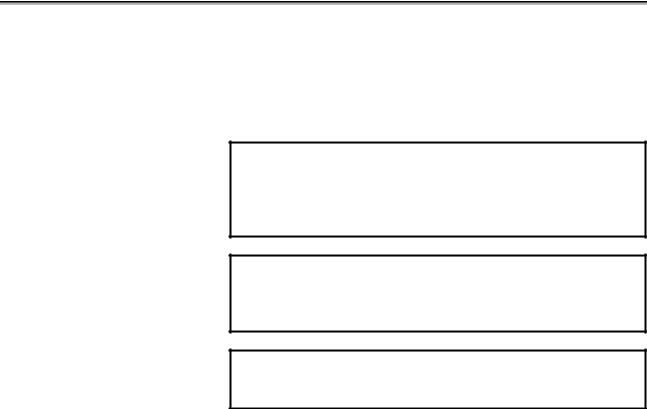fanuc 30iA, 300iA, 300is A, 31iA5, 310iA5 User Manual
...
GE Fanuc Automation
Computer Numerical Control Products
Series 30i/300i/300is-MODEL A
Series 31i/310i/310is-MODEL A5
Series 31i/310i/310is-MODEL A
Series 32i/320i/320is-MODEL A
For Machining Center System
User’s Manual
GFZ-63944EN-2/02 |
June 2004 |

GFL-001
Warnings, Cautions, and Notes as Used in this Publication
Warning
Warning notices are used in this publication to emphasize that hazardous voltages, currents, temperatures, or other conditions that could cause personal injury exist in this equipment or may be associated with its use.
In situations where inattention could cause either personal injury or damage to equipment, a Warning notice is used.
Caution
Caution notices are used where equipment might be damaged if care is not taken.
Note
Notes merely call attention to information that is especially significant to understanding and operating the equipment.
This document is based on information available at the time of its publication. While efforts have been made to be accurate, the information contained herein does not purport to cover all details or variations in hardware or software, nor to provide for every possible contingency in connection with installation, operation, or maintenance. Features may be described herein which are not present in all hardware and software systems. GE Fanuc Automation assumes no obligation of notice to holders of this document with respect to changes subsequently made.
GE Fanuc Automation makes no representation or warranty, expressed, implied, or statutory with respect to, and assumes no responsibility for the accuracy, completeness, sufficiency, or usefulness of the information contained herein. No warranties of merchantability or fitness for purpose shall apply.
©Copyright 2004 GE Fanuc Automation North America, Inc.
All Rights Reserved.

B-63944EN-2/02 |
SAFETY PRECAUTIONS |
SAFETY PRECAUTIONS
This section describes the safety precautions related to the use of CNC units.
It is essential that these precautions be observed by users to ensure the safe operation of machines equipped with a CNC unit (all descriptions in this section assume this configuration). Note that some precautions are related only to specific functions, and thus may not be applicable to certain CNC units.
Users must also observe the safety precautions related to the machine, as described in the relevant manual supplied by the machine tool builder. Before attempting to operate the machine or create a program to control the operation of the machine, the operator must become fully familiar with the contents of this manual and relevant manual supplied by the machine tool builder.
|
CONTENTS |
|
1.1 |
DEFINITION OF WARNING, CAUTION, AND NOTE |
........s-2 |
1.2 |
GENERAL WARNINGS AND CAUTIONS ........................... |
s-3 |
1.3 |
WARNINGS AND CAUTIONS RELATED TO |
|
|
PROGRAMMING..................................................................... |
s-6 |
1.4 |
WARNINGS AND CAUTIONS RELATED TO HANDLINGs-9 |
|
1.5 |
WARNINGS RELATED TO DAILY MAINTENANCE....... |
s-12 |
s-1

SAFETY PRECAUTIONS |
B-63944EN-2/02 |
1.1 DEFINITION OF WARNING, CAUTION, AND NOTE
This manual includes safety precautions for protecting the user and preventing damage to the machine. Precautions are classified into Warning and Caution according to their bearing on safety. Also, supplementary information is described as a Note. Read the Warning, Caution, and Note thoroughly before attempting to use the machine.
 WARNING
WARNING
Applied when there is a danger of the user being injured or when there is a danger of both the user being injured and the equipment being damaged if the approved procedure is not observed.
 CAUTION
CAUTION
Applied when there is a danger of the equipment being damaged, if the approved procedure is not observed.
NOTE
The Note is used to indicate supplementary information other than Warning and Caution.
•Read this manual carefully, and store it in a safe place.
s-2

B-63944EN-2/02 |
SAFETY PRECAUTIONS |
1.2 GENERAL WARNINGS AND CAUTIONS
 WARNING
WARNING
1Never attempt to machine a workpiece without first checking the operation of the machine. Before starting a production run, ensure that the machine is operating correctly by performing a trial run using, for example, the single block, feedrate override, or machine lock function or by operating the machine with neither a tool nor workpiece mounted. Failure to confirm the correct operation of the machine may result in the machine behaving unexpectedly, possibly causing damage to the workpiece and/or machine itself, or injury to the user.
2Before operating the machine, thoroughly check the entered data.
Operating the machine with incorrectly specified data may result in the machine behaving unexpectedly, possibly causing damage to the workpiece and/or machine itself, or injury to the user.
3Ensure that the specified feedrate is appropriate for the intended operation. Generally, for each machine, there is a maximum allowable feedrate. The appropriate feedrate varies with the intended operation. Refer to the manual provided with the machine to determine the maximum allowable feedrate.
If a machine is run at other than the correct speed, it may behave unexpectedly, possibly causing damage to the workpiece and/or machine itself, or injury to the user.
4When using a tool compensation function, thoroughly check the direction and amount of compensation.
Operating the machine with incorrectly specified data may result in the machine behaving unexpectedly, possibly causing damage to the workpiece and/or machine itself, or injury to the user.
s-3

SAFETY PRECAUTIONS |
B-63944EN-2/02 |
 WARNING
WARNING
5The parameters for the CNC and PMC are factory-set. Usually, there is not need to change them. When, however, there is not alternative other than to change a parameter, ensure that you fully understand the function of the parameter before making any change.
Failure to set a parameter correctly may result in the machine behaving unexpectedly, possibly causing damage to the workpiece and/or machine itself, or injury to the user.
6Immediately after switching on the power, do not touch any of the keys on the MDI panel until the position display or alarm screen appears on the
CNC unit.
Some of the keys on the MDI panel are dedicated to maintenance or other special operations. Pressing any of these keys may place the CNC unit in other than its normal state. Starting the machine in this state may cause it to behave unexpectedly.
7The User’s Manual and programming manual supplied with a CNC unit provide an overall description of the machine's functions, including any optional functions. Note that the optional functions will vary from one machine model to another. Therefore, some functions described in the manuals may not actually be available for a particular model. Check the specification of the machine if in doubt.
8Some functions may have been implemented at the request of the machine-tool builder. When using such functions, refer to the manual supplied by the machine-tool builder for details of their use and any related cautions.
 CAUTION
CAUTION
The liquid-crystal display is manufactured with very precise fabrication technology. Some pixels may not be turned on or may remain on. This phenomenon is a common attribute of LCDs and is not a defect.
s-4

B-63944EN-2/02 |
SAFETY PRECAUTIONS |
NOTE
Programs, parameters, and macro variables are stored in nonvolatile memory in the CNC unit. Usually, they are retained even if the power is turned off.
Such data may be deleted inadvertently, however, or it may prove necessary to delete all data from nonvolatile memory as part of error recovery.
To guard against the occurrence of the above, and assure quick restoration of deleted data, backup all vital data, and keep the backup copy in a safe place.
s-5

SAFETY PRECAUTIONS |
B-63944EN-2/02 |
1.3 WARNINGS AND CAUTIONS RELATED TO PROGRAMMING
This section covers the major safety precautions related to programming. Before attempting to perform programming, read the supplied User’s Manual carefully such that you are fully familiar with their contents.
 WARNING
WARNING
1Coordinate system setting
If a coordinate system is established incorrectly, the machine may behave unexpectedly as a result of the program issuing an otherwise valid move command. Such an unexpected operation may damage the tool, the machine itself, the workpiece, or cause injury to the user.
2Positioning by nonlinear interpolation
When performing positioning by nonlinear interpolation (positioning by nonlinear movement between the start and end points), the tool path must be carefully confirmed before performing programming. Positioning involves rapid traverse. If the tool collides with the workpiece, it may damage the tool, the machine itself, the workpiece, or cause injury to the user.
3Function involving a rotation axis
When programming polar coordinate interpolation or normal-direction (perpendicular) control, pay careful attention to the speed of the rotation axis. Incorrect programming may result in the rotation axis speed becoming excessively high, such that centrifugal force causes the chuck to lose its grip on the workpiece if the latter is not mounted securely. Such mishap is likely to damage the tool, the machine itself, the workpiece, or cause injury to the user.
4Inch/metric conversion
Switching between inch and metric inputs does not convert the measurement units of data such as the workpiece origin offset, parameter, and current position. Before starting the machine, therefore, determine which measurement units are being used. Attempting to perform an operation with invalid data specified may damage the tool, the machine itself, the workpiece, or cause injury to the user.
s-6

B-63944EN-2/02 |
SAFETY PRECAUTIONS |
 WARNING
WARNING
5Constant surface speed control
When an axis subject to constant surface speed control approaches the origin of the workpiece coordinate system, the spindle speed may become excessively high. Therefore, it is necessary to specify a maximum allowable speed. Specifying the maximum allowable speed incorrectly may damage the tool, the machine itself, the workpiece, or cause injury to the user.
6Stroke check
After switching on the power, perform a manual reference position return as required. Stroke check is not possible before manual reference position return is performed. Note that when stroke check is disabled, an alarm is not issued even if a stroke limit is exceeded, possibly damaging the tool, the machine itself, the workpiece, or causing injury to the user.
7Tool post interference check
A tool post interference check is performed based on the tool data specified during automatic operation. If the tool specification does not match the tool actually being used, the interference check cannot be made correctly, possibly damaging the tool or the machine itself, or causing injury to the user. After switching on the power, or after selecting a tool post manually, always start automatic operation and specify the tool number of the tool to be used.
8Absolute/incremental mode
If a program created with absolute values is run in incremental mode, or vice versa, the machine may behave unexpectedly.
9Plane selection
If an incorrect plane is specified for circular interpolation, helical interpolation, or a canned cycle, the machine may behave unexpectedly.
Refer to the descriptions of the respective functions for details.
10Torque limit skip
Before attempting a torque limit skip, apply the torque limit. If a torque limit skip is specified without the torque limit actually being applied, a move command will be executed without performing a skip.
s-7

SAFETY PRECAUTIONS |
B-63944EN-2/02 |
 WARNING
WARNING
11 Programmable mirror image
Note that programmed operations vary considerably when a programmable mirror image is enabled.
12 Compensation function
If a command based on the machine coordinate system or a reference position return command is issued in compensation function mode, compensation is temporarily canceled, resulting in the unexpected behavior of the machine.
Before issuing any of the above commands, therefore, always cancel compensation function mode.
s-8

B-63944EN-2/02 |
SAFETY PRECAUTIONS |
1.4 WARNINGS AND CAUTIONS RELATED TO HANDLING
This section presents safety precautions related to the handling of machine tools. Before attempting to operate your machine, read the supplied User’s Manual carefully, such that you are fully familiar with their contents.
 WARNING
WARNING
1Manual operation
When operating the machine manually, determine the current position of the tool and workpiece, and ensure that the movement axis, direction, and feedrate have been specified correctly. Incorrect operation of the machine may damage the tool, the machine itself, the workpiece, or cause injury to the operator.
2Manual reference position return
After switching on the power, perform manual reference position return as required.
If the machine is operated without first performing manual reference position return, it may behave unexpectedly. Stroke check is not possible before manual reference position return is performed. An unexpected operation of the machine may
damage the tool, the machine itself, the workpiece, or cause injury to the user.
3Manual numeric command
When issuing a manual numeric command, determine the current position of the tool and workpiece, and ensure that the movement axis, direction, and command have been specified correctly, and that the entered values are valid.
Attempting to operate the machine with an invalid command specified may damage the tool, the machine itself, the workpiece, or cause injury to the operator.
4Manual handle feed
In manual handle feed, rotating the handle with a large scale factor, such as 100, applied causes the tool and table to move rapidly. Careless handling may damage the tool and/or machine, or cause injury to the user.
s-9

SAFETY PRECAUTIONS |
B-63944EN-2/02 |
 WARNING
WARNING
5Disabled override
If override is disabled (according to the specification in a macro variable) during threading, rigid tapping, or other tapping, the speed cannot be predicted, possibly damaging the tool, the machine itself, the workpiece, or causing injury to the operator.
6Origin/preset operation
Basically, never attempt an origin/preset operation when the machine is operating under the control of a program. Otherwise, the machine may behave unexpectedly, possibly damaging the tool, the machine itself, the tool, or causing injury to the user.
7Workpiece coordinate system shift
Manual intervention, machine lock, or mirror imaging may shift the workpiece coordinate system. Before attempting to operate the machine under the control of a program, confirm the coordinate system carefully.
If the machine is operated under the control of a program without making allowances for any shift in the workpiece coordinate system, the machine may behave unexpectedly, possibly damaging the tool, the machine itself, the workpiece, or causing injury to the operator.
8Software operator's panel and menu switches
Using the software operator's panel and menu switches, in combination with the MDI panel, it is possible to specify operations not supported by the machine operator's panel, such as mode change, override value change, and jog feed commands. Note, however, that if the MDI panel keys are operated inadvertently, the machine may behave unexpectedly, possibly damaging the tool, the machine itself, the workpiece, or causing injury to the user.
9RESET key
Pressing the RESET key stops the currently running program. As a result, the servo axes are stopped. However, the RESET key may fail to function for reasons such as an MDI panel problem. So, when the motors must be stopped, use the emergency stop button instead of the RESET key to ensure security.
s-10

B-63944EN-2/02 |
SAFETY PRECAUTIONS |
 WARNING
WARNING
10 Manual intervention
If manual intervention is performed during programmed operation of the machine, the tool path may vary when the machine is restarted.
Before restarting the machine after manual intervention, therefore, confirm the settings of the manual absolute switches, parameters, and absolute/incremental command mode.
11 Feed hold, override, and single block
The feed hold, feedrate override, and single block functions can be disabled using custom macro system variable #3004. Be careful when operating the machine in this case.
12 Dry run
Usually, a dry run is used to confirm the operation of the machine. During a dry run, the machine operates at dry run speed, which differs from the corresponding programmed feedrate. Note that the dry run speed may sometimes be higher than the programmed feed rate.
13 Cutter and tool nose radius compensation in
MDI mode
Pay careful attention to a tool path specified by a command in MDI mode, because cutter or tool nose radius compensation is not applied. When a command is entered from the MDI to interrupt in automatic operation in cutter or tool nose radius compensation mode, pay particular attention to the tool path when automatic operation is subsequently resumed. Refer to the descriptions of the corresponding functions for details.
14 Program editing
If the machine is stopped, after which the machining program is edited (modification, insertion, or deletion), the machine may behave unexpectedly if machining is resumed under the control of that program. Basically, do not modify, insert, or delete commands from a machining program while it is in use.
s-11

SAFETY PRECAUTIONS |
B-63944EN-2/02 |
1.5 WARNINGS RELATED TO DAILY MAINTENANCE
 WARNING
WARNING
1Memory backup battery replacement
When replacing the memory backup batteries, keep the power to the machine (CNC) turned on, and apply an emergency stop to the machine.
Because this work is performed with the power on and the cabinet open, only those personnel who have received approved safety and maintenance training may perform this work.
When replacing the batteries, be careful not to touch the high-voltage circuits (marked  and fitted with an insulating cover).
and fitted with an insulating cover).
Touching the uncovered high-voltage circuits presents an extremely dangerous electric shock hazard.
NOTE
The CNC uses batteries to preserve the contents of its memory, because it must retain data such as programs, offsets, and parameters even while external power is not applied.
If the battery voltage drops, a low battery voltage alarm is displayed on the machine operator's panel or screen.
When a low battery voltage alarm is displayed, replace the batteries within a week. Otherwise, the contents of the CNC's memory will be lost.
Refer to the Section “Method of replacing battery” in the User’s Manual (Common to T/M series) for details of the battery replacement procedure.
s-12

B-63944EN-2/02 |
SAFETY PRECAUTIONS |
 WARNING
WARNING
2Absolute pulse coder battery replacement
When replacing the memory backup batteries, keep the power to the machine (CNC) turned on, and apply an emergency stop to the machine.
Because this work is performed with the power on and the cabinet open, only those personnel who have received approved safety and maintenance training may perform this work.
When replacing the batteries, be careful not to touch the high-voltage circuits (marked  and fitted with an insulating cover).
and fitted with an insulating cover).
Touching the uncovered high-voltage circuits presents an extremely dangerous electric shock hazard.
NOTE
The absolute pulse coder uses batteries to preserve its absolute position.
If the battery voltage drops, a low battery voltage alarm is displayed on the machine operator's panel or screen.
When a low battery voltage alarm is displayed, replace the batteries within a week. Otherwise, the absolute position data held by the pulse coder will be lost.
Refer to the FANUC SERVO MOTOR αi series Maintenance Manual for details of the battery replacement procedure.
s-13

SAFETY PRECAUTIONS |
B-63944EN-2/02 |
 WARNING
WARNING
3Fuse replacement
Before replacing a blown fuse, however, it is necessary to locate and remove the cause of the blown fuse.
For this reason, only those personnel who have received approved safety and maintenance training may perform this work.
When replacing a fuse with the cabinet open, be careful not to touch the high-voltage circuits (marked  and fitted with an insulating cover).
and fitted with an insulating cover).
Touching an uncovered high-voltage circuit presents an extremely dangerous electric shock hazard.
s-14

B-63944EN-2/02 |
TABLE OF CONTENTS |
TABLE OF CONTENTS
SAFETY PRECAUTIONS............................................................................ |
s-1 |
|||
I. GENERAL |
|
|
||
1 |
GENERAL |
............................................................................................... |
3 |
|
|
1.1 |
NOTES ON READING THIS MANUAL.......................................................... |
7 |
|
|
1.2 |
NOTES ......................................................ON VARIOUS KINDS OF DATA |
7 |
|
II. PROGRAMMING |
|
|||
1 |
GENERAL ............................................................................................. |
|
11 |
|
|
1.1 |
TOOL .................................FIGURE AND TOOL MOTION BY PROGRAM |
12 |
|
2 PREPARATORY ......................................FUNCTION (G FUNCTION) |
13 |
|||
3 |
INTERPOLATION ..............................................................FUNCTION |
18 |
||
|
3.1 |
INVOLUTE ............................................INTERPOLATION (G02.2, G03.2) |
19 |
|
|
|
3.1.1 .............................................. |
Automatic Speed Control for Involute Interpolation |
24 |
|
|
3.1.2 ....................................................... |
Helical Involute Interpolation (G02.2, G03.2) |
26 |
|
|
3.1.3 ............... |
Involute Interpolation on Linear Axis and Rotary Axis (G02.2, G03.2) |
27 |
|
3.2 |
THREADING .....................................................................................(G33) |
30 |
|
4 COORDINATE ...........................................VALUE AND DIMENSION |
32 |
|||
|
4.1 |
POLAR .........................................COORDINATE COMMAND (G15, G16) |
33 |
|
5 FUNCTIONS .....................................TO SIMPLIFY PROGRAMMING |
37 |
|||
|
5.1 |
CANNED ...............................................................CYCLE FOR DRILLING |
38 |
|
|
|
5.1.1 .................................................................. |
High - Speed Peck Drilling Cycle (G73) |
43 |
|
|
5.1.2 ........................................................................ |
Left - Handed Tapping Cycle (G74) |
45 |
|
|
5.1.3 ........................................................................................ |
Fine Boring Cycle (G76) |
47 |
|
|
5.1.4 ....................................................................... |
Drilling Cycle, Spot Drilling (G81) |
49 |
|
|
5.1.5 .......................................................... |
Drilling Cycle Counter Boring Cycle (G82) |
51 |
|
|
5.1.6 ...................................................................................... |
Peck Drilling Cycle (G83) |
53 |
|
|
5.1.7 ............................................................................. |
Small - Hole Peck Drilling Cycle |
55 |
|
|
5.1.8 .............................................................................................. |
Tapping Cycle (G84) |
60 |
|
|
5.1.9 ................................................................................................ |
Boring Cycle (G85) |
62 |
|
|
5.1.10 ................................................................................................ |
Boring Cycle (G86) |
64 |
|
|
5.1.11 ....................................................................................... |
Back Boring Cycle (G87) |
66 |
|
|
5.1.12 ................................................................................................ |
Boring Cycle (G88) |
69 |
|
|
|
c - 1 |
|
TABLE OF CONTENTS |
B-63944EN-2/02 |
|||
|
5.1.13 |
Boring Cycle (G89)................................................................................................ |
71 |
|
|
5.1.14 |
Canned Cycle Cancel for Drilling (G80)................................................................ |
73 |
|
|
5.1.15 |
Example for Using Canned Cycles for Drilling ..................................................... |
74 |
|
5.2 |
RIGID TAPPING.......................................................................................... |
76 |
||
|
5.2.1 |
Rigid Tapping (G84) .............................................................................................. |
77 |
|
|
5.2.2 |
Left-Handed Rigid Tapping Cycle (G74)............................................................... |
81 |
|
|
5.2.3 |
Peck Rigid Tapping Cycle (G84 or G74)............................................................... |
85 |
|
|
5.2.4 |
Canned Cycle Cancel (G80)................................................................................... |
89 |
|
|
5.2.5 |
Override during Rigid Tapping .............................................................................. |
90 |
|
|
|
5.2.5.1 |
Extraction override ............................................................................................ |
90 |
|
|
5.2.5.2 |
Override signal .................................................................................................. |
92 |
5.3 |
OPTIONAL CHAMFERING AND CORNER R............................................. |
93 |
||
5.4 |
INDEX TABLE INDEXING FUNCTION........................................................ |
97 |
||
6 COMPENSATION FUNCTION............................................................ |
100 |
|||
6.1 |
TOOL LENGTH COMPENSATION SHIFT TYPES ................................... |
101 |
||
6.2 |
AUTOMATIC TOOL LENGTH MEASUREMENT (G37) ............................ |
106 |
||
6.3 |
TOOL OFFSET (G45 TO G48).................................................................. |
110 |
||
6.4 |
OVERVIEW OF CUTTER COMPENSATION (G40-G42).......................... |
115 |
||
6.5 |
OVERVIEW OF TOOL NOSE RADIUS COMPENSATION (G40-G42) ..... |
122 |
||
|
6.5.1 |
Imaginary Tool Nose............................................................................................ |
122 |
|
|
6.5.2 |
Direction of Imaginary Tool Nose ....................................................................... |
124 |
|
|
6.5.3 |
Offset Number and Offset Value.......................................................................... |
126 |
|
|
6.5.4 |
Workpiece Position and Move Command............................................................ |
127 |
|
|
6.5.5 |
Notes on Tool Nose Radius Compensation.......................................................... |
134 |
|
6.6 |
DETAILS OF CUTTER OR TOOL NOSE RADIUS COMPENSATION...... |
136 |
||
|
6.6.1 |
Overview .............................................................................................................. |
136 |
|
|
6.6.2 |
Tool Movement in Start-up .................................................................................. |
140 |
|
|
6.6.3 |
Tool Movement in Offset Mode........................................................................... |
146 |
|
|
6.6.4 |
Tool Movement in Offset Mode Cancel............................................................... |
167 |
|
|
6.6.5 |
Prevention of Overcutting Due to Cutter or Tool Nose Radius Compensation ... |
175 |
|
|
6.6.6 |
Interference Check ............................................................................................... |
179 |
|
|
|
6.6.6.1 Operation to be performed if an interference is judged to occur ..................... |
183 |
|
|
|
6.6.6.2 Interference check alarm function ................................................................... |
184 |
|
|
|
6.6.6.3 Interference check avoidance function ............................................................ |
186 |
|
|
6.6.7 |
Cutter or Tool Nose Radius Compensation for Input from MDI ......................... |
193 |
|
6.7 |
VECTOR RETENTION (G38).................................................................... |
195 |
||
6.8 |
CORNER CIRCULAR INTERPOLATION (G39) ........................................ |
196 |
||
c-2

B-63944EN-2/02 |
TABLE OF CONTENTS |
|
6.9 |
THREE-DIMENSIONAL CUTTER COMPENSATION (G40, G41) ............ |
198 |
6.10TOOL COMPENSATION VALUES, NUMBER OF COMPENSATION
VALUES, AND ENTERING VALUES FROM THE PROGRAM (G10) ....... |
203 |
6.11 COORDINATE SYSTEM ROTATION (G68, G69)..................................... |
207 |
6.12ACTIVE OFFSET VALUE CHANGE FUNCTION BASED ON MANUAL
|
|
FEED ......................................................................................................... |
214 |
|
6.13 |
ROTARY TABLE DYNAMIC FIXTURE OFFSET....................................... |
219 |
|
6.14 |
NORMAL DIRECTION CONTROL (G40.1, G41.1, G42.1)........................ |
226 |
7 MEMORY OPERATION USING Series 15 PROGRAM FORMAT ..... |
231 |
||
8 |
AXIS CONTROL FUNCTIONS............................................................ |
232 |
|
|
8.1 |
TANDEM CONTROL ................................................................................. |
233 |
|
8.2 |
CHOPPING FUNCTION ............................................................................ |
234 |
III. OPERATION |
|
||
1 SETTING AND DISPLAYING DATA................................................... |
245 |
||
|
1.1 |
SCREENS DISPLAYED BY FUNCTION KEY SETTING .................................. |
246 |
|
|
OFFSET |
|
|
|
1.1.1 Setting and Displaying the Tool Compensation Value ........................................ |
247 |
|
|
1.1.2 Tool Length Measurement ................................................................................... |
250 |
|
|
1.1.3 Tool Length/Workpiece Origin Measurement B.................................................. |
252 |
|
|
1.1.4 Setting and Displaying the Rotary Table Dynamic Fixture Offset ...................... |
271 |
APPENDIX |
|
||
A |
PARAMETERS.................................................................................... |
277 |
|
|
A.1 |
DESCRIPTION OF PARAMETERS........................................................... |
278 |
|
A.2 |
DATA TYPE............................................................................................... |
314 |
|
A.3 |
STANDARD PARAMETER SETTING TABLES......................................... |
315 |
c-3
I. GENERAL

B-63944EN-2/02 |
GENERAL |
1.GENERAL |
1 GENERAL
This manual consists of the following parts:
About this manual
I.GENERAL
Describes chapter organization, applicable models, related manuals, and notes for reading this manual.
II.PROGRAMMING
Describes each function: Format used to program functions in the NC language, characteristics, and restrictions.
III.OPERATION
Describes the manual operation and automatic operation of a machine, procedures for inputting and outputting data, and procedures for editing a program.
APPENDIX
Lists parameters.
NOTE
1This manual describes the functions that can operate in the machining center system path control type. For other functions not specific to the lathe system, refer to the User's Manual (Common to Lathe System/Machining Center System) (B-
63944EN).
2Some functions described in this manual may not be applied to some products. For detail, refer to the DESCRIPTIONS manual (B-63942EN).
3This manual does not detail the parameters not mentioned in the text. For details of those parameters, refer to the parameter manual (B-
63950EN).
Parameters are used to set functions and operating conditions of a CNC machine tool, and frequently-used values in advance. Usually, the machine tool builder factory-sets parameters so that the user can use the machine tool easily.
4This manual describes not only basic functions but also optional functions. Look up the options incorporated into your system in the manual written by the machine tool builder.
- 3 -

1.GENERAL |
GENERAL |
B-63944EN-2/02 |
Applicable models
The models covered by this manual, and their abbreviations are :
Model name |
|
Abbreviation |
|
FANUC Series 30i-MODEL A |
30i –A |
|
Series 30i |
FANUC Series 300i-MODEL A |
300i–A |
|
Series 300i |
FANUC Series 300is-MODEL A |
300is–A |
|
Series 300is |
FANUC Series 31i-MODEL A |
31i –A |
|
Series 31i |
FANUC Series 31i-MODEL A5 |
31i –A5 |
|
|
|
|
||
FANUC Series 310i-MODEL A |
310i–A |
|
Series 310i |
FANUC Series 310i-MODEL A5 |
310i–A5 |
|
|
|
|
||
FANUC Series 310is-MODEL A |
310is–A |
|
Series 310is |
FANUC Series 310is-MODEL A5 |
310is–A5 |
|
|
|
|
||
FANUC Series 32i-MODEL A |
32i –A |
|
Series 32i |
FANUC Series 320i-MODEL A |
320i–A |
|
Series 320i |
FANUC Series 320is-MODEL A |
320is–A |
|
Series 320is |
NOTE
1Unless otherwise noted, the model names
31i/310i/310is-A, 31i/310i/310is-A5, and
32i/320i/320is-A are collectively referred to as
30i/300i/300is. However, this convention is not necessarily observed when item 3 below is applicable.
2Some functions described in this manual may not be applied to some products.
For details, refer to the DESCRIPTIONS (B- 63942EN).
Special symbols
This manual uses the following symbols:
- IP
Indicates a combination of axes such as X_ Y_ Z_
In the underlined position following each address, a numeric value such as a coordinate value is placed (used in PROGRAMMING.).
- ;
Indicates the end of a block. It actually corresponds to the ISO code LF or EIA code CR.
- 4 -
B-63944EN-2/02 |
GENERAL |
1.GENERAL |
Related manuals of
Series 30i/300i/300is- MODEL A
Series 31i/310i/310is- MODEL A
Series 31i/310i/310is- MODEL A5
Series 32i/320i/320is- MODEL A
The following table lists the manuals related to Series 30i/300i /300is- A, Series 31i/310i /310is-A, Series 31i/310i /310is-A5, Series 32i/320i /320is-A. This manual is indicated by an asterisk(*).
Table 1 Related manuals
Manual name |
Specification |
|
|
number |
|
DESCRIPTIONS |
B-63942EN |
|
CONNECTION MANUAL (HARDWARE) |
B-63943EN |
|
CONNECTION MANUAL (FUNCTION) |
B-63943EN-1 |
|
USER’S MANUAL |
B-63944EN |
|
(Common to Lathe System/Machining Center System) |
|
|
USER’S MANUAL (For Lathe System) |
B-63944EN-1 |
|
USER’S MANUAL (For Lathe Machining Center System) |
B-63944EN-2 |
* |
MAINTENANCE MANUAL |
B-63945EN |
|
PARAMETER MANUAL |
B-65950EN |
|
Programming |
|
|
Macro Compiler / Macro Executor PROGRAMMING |
B-63943EN-2 |
|
MANUAL |
|
|
Macro Compiler OPERATOR’S MANUAL |
B-66264EN |
|
C Language Executor OPERATOR’S MANUAL |
B-63944EN-3 |
|
PMC |
|
|
PMC PROGRAMMING MANUAL |
B-63983EN |
|
Network |
|
|
PROFIBUS-DP Board OPERATOR’S MANUAL |
B-63994EN |
|
Fast Ethernet / Fast Data Server OPERATOR’S MANUAL |
B-64014EN |
|
DeviceNet Board OPERATOR’S MANUAL |
B-64044EN |
|
Operation guidance function |
|
|
MANUAL GUIDE i OPERATOR’S MANUAL |
B-63874EN |
|
MANUAL GUIDE i Set-up Guidance |
B-63874EN-1 |
|
OPERATOR’S MANUAL |
|
|
- 5 -

1.GENERAL GENERAL B-63944EN-2/02
Related manuals of SERVO MOTOR αis/αi/βis/βi series
The following table lists the manuals related to SERVO MOTOR αis/αi/βis/βi series
Table 2 Related manuals
Manual name |
Specification |
|
number |
||
|
FANUC AC SERVO MOTOR αis series |
|
|
FANUC AC SERVO MOTOR αi series |
B-65262EN |
|
DESCRIPTIONS |
|
|
FANUC AC SPINDLE MOTOR αi series |
B-65272EN |
|
DESCRIPTIONS |
||
|
||
FANUC AC SERVO MOTOR βis series |
B-65302EN |
|
DESCRIPTIONS |
||
|
||
FANUC AC SPINDLE MOTOR βi series |
B-65312EN |
|
DESCRIPTIONS |
||
|
||
FANUC SERVO AMPLIFIER αi series |
B-65282EN |
|
DESCRIPTIONS |
||
|
||
FANUC SERVO AMPLIFIER βi series |
B-65322EN |
|
DESCRIPTIONS |
||
|
||
FANUC SERVO MOTOR αis series |
|
|
FANUC SERVO MOTOR αi series |
|
|
FANUC AC SPINDLE MOTOR αi series |
B-65285EN |
|
FANUC SERVO AMPLIFIER αi series |
|
|
MAINTENANCE MANUAL |
|
|
FANUC SERVO MOTOR βis series |
|
|
FANUC AC SPINDLE MOTOR βi series |
B-65325EN |
|
FANUC SERVO AMPLIFIER βi series |
||
|
||
MAINTENANCE MANUAL |
|
|
FANUC AC SERVO MOTOR αis series |
|
|
FANUC AC SERVO MOTOR αi series |
B-65270EN |
|
FANUC AC SERVO MOTOR βis series |
||
|
||
PARAMETER MANUAL |
|
|
FANUC AC SPINDLE MOTOR αi series |
|
|
FANUC AC SPINDLE MOTOR βi series |
B-65280EN |
|
PARAMETER MANUAL |
|
Any of the servo motors and spindles listed above can be connected to the CNC described in this manual. However, αi series servo amplifiers can only be connected to αi series SVMs (for 30i/31i/32i).
This manual mainly assumes that the FANUC SERVO MOTOR αi series of servo motor is used. For servo motor and spindle information, refer to the manuals for the servo motor and spindle that are actually connected.
- 6 -

B-63944EN-2/02 |
GENERAL |
1.GENERAL |
1.1 NOTES ON READING THIS MANUAL
 CAUTION
CAUTION
1The function of an CNC machine tool system depends not only on the CNC, but on the combination of the machine tool, its magnetic cabinet, the servo system, the CNC, the operator's panels, etc. It is too difficult to describe the function, programming, and operation relating to all combinations. This manual generally describes these from the stand-point of the CNC. So, for details on a particular CNC machine tool, refer to the manual issued by the machine tool builder, which should take precedence over this manual.
2In the header field of each page of this manual, a chapter title is indicated so that the reader can reference necessary information easily.
By finding a desired title first, the reader can reference necessary parts only.
3This manual describes as many reasonable variations in equipment usage as possible. It cannot address every combination of features, options and commands that should not be attempted.
If a particular combination of operations is not described, it should not be attempted.
1.2NOTES ON VARIOUS KINDS OF DATA
 CAUTION
CAUTION
Machining programs, parameters, offset data, etc. are stored in the CNC unit internal non-volatile memory. In general, these contents are not lost by the switching ON/OFF of the power. However, it is possible that a state can occur where precious data stored in the non-volatile memory has to be deleted, because of deletions from a maloperation, or by a failure restoration. In order to restore rapidly when this kind of mishap occurs, it is recommended that you create a copy of the various kinds of data beforehand.
- 7 -
II. PROGRAMMING
